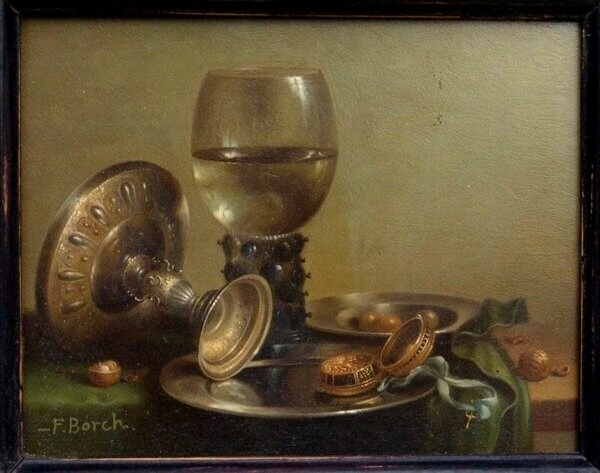
Overturned Silver Tazza, Goblet, and Watch on a Draped Table
F. Borch in the Manner of Willem Claesz Heda (1594-1680)
Late 19th Century
Offers
Shipping $99 Standard Parcel View Options
Questions about this piece
Item Details:
AN OVERTURNED SILVER TAZZA, GOBLET, AND POCKET WATCH WITH A KEY ON A BLUE SILK RIBBON ALL ON A PEWTER PLATE ON A PARTIALLY-DRAPED TABLE
F. BORCH IN THE MANNER OF WILLEM CLAESZ HEDA (1594-1680)
LATE 19th CENTURY
Oil Painting on Board
Size: 10.0 x 8.0 in; 25.4 x 20.32 cm
Signed: Recto, lower left
The word "vanitas" is Latin for "vanity". A vanitas painting tries to convey the essential meaninglessness of earthly goods and pursuits, when compared with the eternal nature of true Christian values. It is associated with a verse from the Bible - "Vanity of vanities, everything is vanity" (Ecclesiastes 1:2;12:8). A vanitas picture contains collections of objects symbolic of the transitory nature of life, the vanity of wealth and the inevitability of death. Viewers are asked to reconsider their misguided coveting of worldly pleasures and possessions, to remember their mortality, and to repent for their sins. Vanitas still lifes - the only religious art approved of in Holland - appealed to wealthy Protestants for their realism and moralistic message, but also (one suspects) because they helped to ease their conscience for having acquired so much worldly wealth. Typical motifs used in 17th century vanitas paintings included a number of standard elements, symbolizing: (1) Wealth and power - like gold, jewellery, coins, purses; (2) Earthly pleasures - such as luxury fabrics, pipes, wine glasses, dice, playing cards; (3) Secular knowledge - like books, inkpots and pens, maps, telescopes; (4) Inevitability of death/ passage of time (associated with the Memento mori theme) - skull, hourglass, chronometer, watch, burning candle, butterflies, flowers, fruit. Sometimes the featured objects would be jumbled up in disarray, signifying the inherent weakness or futility of the achievements they symbolize. A peeled lemon shows that things may look attractive but still have a bitter taste. Nothing could express the egotism and transitory quality of life better than the 'skull'. In searching for contact with the viewer of the painting with its deep dark eye sockets, it signifies not only its own evanescence, but also that of all of mankind and all human pursuits.
Creator: F. Borch in the Manner of Willem Claesz Heda (1594-1680)
Creation Year: Late 19th Century
Dimensions: 10.0 x 8.0 in
Medium: Oil Painting on Board
Movement/Style: Baroque (after)
Period: 1875-1899
Condition: Very Good
